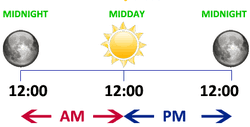LESSON PLAN OF TIME (RECOGNIZE AM AND PM)
LESSON PLANNING OF TIME (RECOGNIZE AM AND
PM)
Subject Mathematics
Grade 2nd
Students` Learning Outcomes
- Recognize am and pm.
- Draw hands of a clock to show time in hours and minutes (with five minutes intervals)
Information for Teachers
- The time from last midnight to next midnight
is called one day.
- The minute hand of clock goes round the dial 24 times in one day (day and night)
- The hour hand of clock goes round the dial twice in one day (day and night)
- So, when the hour hand one round complete in 12 hours, i.e. two rounds in 24 hours.
- Thus we can also divide one day (day and night) into two equal halves.
- Thus division of one day (day and night) always starts from right 12 o`clock and next night after 12 o`clock we count new day.
- In order to differentiate between two parts of a day, we use am and pm.
- Time after midnight to noon is represented by “am” and time after noon to midnight is represented by “pm”.
Material / Resources
Writing board, chalk / marker, duster, analog
clock, work sheet of clock dials, worksheet showing time on clock dials,
textbook
Introduction
Activity 1
- As the following questions from the students:
- How many times the hour hand goes round the clock dial in one day?
- In how many hours the hour hand completes its one round around the dial?
- There are how many hours in a day?
- How day and night time can be differentiating?
Development
Activity 1
- Narrate a situation, e.g. Hammed calls to his friend Ali, and inform him that “Ali see you at 7:30 tomorrow.
- Does Ali understand that Hammed wants to meet him either 7:30 of night or morning? (No)
- If students are unable to tell, you tell them that in one day (day & night) the hour hand crosses each number twice, once after 12 o`clock at night and once after 12 o`clock at noon.
- Hence we divide the one day into two equal halves, from midnight to noon and then from noon to next midnight.
- This division of one day (day & night) always starts from night 12 o`clock and next night after 12 o`clock, we count new day / date.
- In order to differentiate between two parts of a day, we use ‘am’ and ‘p’.
- Time after midnight to noon is represented by “am” and time after noon to midnight is represented by “pm”.
- Repeat the concept of 24 hours from the previous lesson in which the picture showing the position of the sun and the moon.
- Ask students to look at the diagram and tell the new date / day starts, is the sun risen yet or not?
- Ask more questions related to the diagram.
- Help students to understand that new date / day begin at midnight.
Activity 2
- After setting the clock on 9:00, ask, what is the time?
- Is it morning time or evening time?
- How we will show, 9 o`clock of night?
- Tell the students that we write ‘am’ to show 9 o`clock of morning and ‘pm’ to show 9 o`clock of night.
- Repeat this concept many times by showing different time on clock so that the entire student understands.
- Now show different time on clock and ask if it is the evening time than how I will show it and if it is morning time then how it will be represented?
- Write different time on board and also write morning, noon, evening, night with them and ask students about am and pm.
Activity 3
- Divide the students into four groups.
- Provide them work sheet and ask them to show the given time in “am” and “pm”.
- Ask groups to present their work in front of the class after completion.
Activity 4
- Divide the students in five groups.
- Provide them following work sheet of clock dial without hands.
- Ask them to draw the hands according to indicated time.
- Ask them to show the hands with different colors.
- Ask them to present their work in front of class.
Sum up / Conclusion
- The time from last midnight to next midnight is called one day.
- The hour hand of clock goes round the dial twice in one day (day and night)
- The hour hand one round completes in 12 hours, i.e. two rounds in 24 hours.
- Thus we can also divide the day (day and night) into two equal halves.
- This division of one day (day and night) always starts from night 12 o`clock and next night after 12 o`clock we count new day.
- In order to differentiate between two parts of a day, we use ‘am and ‘pm’.
- ‘Am’ is used for the time after 12:00 midnight and before 12:00 noon.
- ‘pm’ is used for the time after 12:00 noon and before 12:00 midnight.
- The movement of minute hand is faster than that of the hour`s hand.
Assessment
- Ask students to tell time according to ‘am’ and ‘pm’.
- At what time did you get up today?
- When did you leave home for school?
- At what time did the first period end in school?
- At what time did you reach home yesterday?
- At what time did you go to bed yesterday?
- At what time does your favorite T.V. program start?
- If now 11 o`clock of morning than after three hours how we will show the time in ‘am’ or ‘pm’.
- Ask what have you learnt from today`s lesson.
Follow up
- Draw clock on chart and show the timings of five prayers with the help of clock hands and also write these timings with ‘am’ and ‘pm’.
- Ask them to bring this chart next day.
- Observe time in ‘am’ and ‘pm’ on mobile or digital clock.
- Ask the students to solve the questions given in their textbook.










Comments
Post a Comment